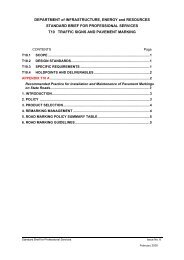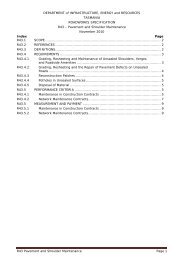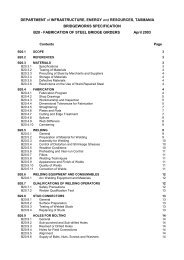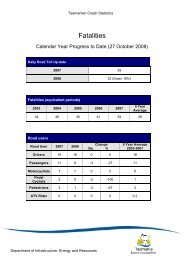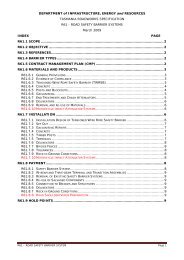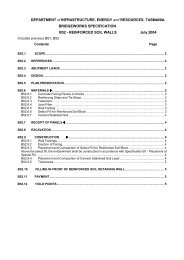Public Environment Report Tarkine Forest Drive ... - Transport
Public Environment Report Tarkine Forest Drive ... - Transport
Public Environment Report Tarkine Forest Drive ... - Transport
- No tags were found...
You also want an ePaper? Increase the reach of your titles
YUMPU automatically turns print PDFs into web optimized ePapers that Google loves.
No threats to this species will be derived from this action. None of the activities listedabove are likely to be changed by the proposed action.There are no known pests or diseases that impact on this species. Neither thepreferred grassy habitat nor the species is susceptible to Phytophthora cinnamomi. Fireoutbreaks are not likely to adversely affect this species as the habitat is unlikely to beflammable during the spring flowering period. Orchids are adapted to fire and typicallybenefit from periodic burns. Fire is used as a tool for habitat management (ThreatenedSpecies Section 2010).SurveyThe record from Arthur Pieman Conservation Area is described as Tiger Flats (SegmentB), an area renowned for several other threatened orchid species. It has not beenrecorded since 1990 and location information is uncertain (NBES 2011).The roadside in the vicinity of potential habitat were targeted for survey (as outlinedin section 4.9.2).Fire promotes flowering in this species. The area burnt in autumn 2009 between theaccess tracks to Sarah Ann Rocks and Couta Rocks had the greatest potential to haveflowering plants of this species evident in the spring of 2009. Targeted searchesundertaken in November 2009 (during the peak flowering period) did not record thisspecies, although the Tiger Flats area had not been subject to fire (NBES 2011).4.10.5 Pretty Leek-orchid (Prasophyllum pulchellum)AbundanceThe estimated total population of pretty leek-orchid was 130 plants in 2000(Threatened Species Unit 2000c). There were five populations with one in thenorthwest in the vicinity of Arthur River Road / Bluff Hill Point Road junctionapproximately 2km north of Arthur River township. Since that time it has been found tobe more widespread in the region being recorded from three separated roadside siteson the Western Explorer (9-20km south of the <strong>Tarkine</strong> <strong>Forest</strong> <strong>Drive</strong>), plus two sites offTemma Road. One of these is approximately 2km south of the Couta Rocks Rd junction,but the latest observation (from spring 2011) located a patch of 6 plants less than200m east of the Temma Road adjacent to Segment B. Total numbers in the northwest, based on Natural Values Atlas data, appear to be as many as 150 individualssuggesting the overall population is significantly elevated above that known in 2000and reported in the Listing Statement at the time.Recent observations are well dispersed, in contrast to some of the other localisedorchids. It is likely that there are other currently unrecorded populations in moreremote sites that are less easily accessed. The habitat of these new records isextensive in the area, unlike some of the other orchids described in this section.Distribution, ecology and habitat preferencePretty leek-orchid is endemic to Tasmania, but is widespread, with records from thecentral north, the Tasman Peninsula and the far south east (Figure 4.8). The area ofoccupancy has not been quantified, but was considered to be



